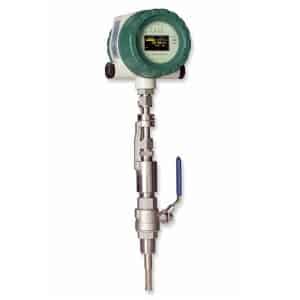Ethanol Production and GHG Reporting
The use of thermal mass flow meters provides accurate and reliable measurement of natural gas flow versus other conventional measurement options during ethanol production and GHG emissions reporting.
Ethanol Fuel

Ethanol, or ethanol fuel, or ethyl alcohol is the alcohol found in alcoholic beverages. Ethanol is also a biofuel additive for gasoline. Automobiles today can run on an ethanol fuel mix of gasoline and ethanol. The mix is typically 90% gasoline with 10% ethanol (E10) or 85% gasoline with 15% ethanol (E15). In the United States ethanol is produced primarily from corn although sugarcane is the predominant source of ethanol elsewhere. Ethanol is used to oxygenate the fuel and reduce air pollution.
GHG Emissions Measurement
The Renewable Fuel Standard (RFS) is a U.S. federal[AM1] program requiring transportation fuel sold in the United States to have a minimum amount of renewable fuels. The program began with the Energy Policy Act of 2005 and was expanded and extended by the Energy Independence and Security Act of 2007 (EISA). RFS requires renewable fuel to be blended into transportation fuel in increasing amounts each year, escalating to 36 billion gallons by 2022. Each renewable fuel category in the RFS program must emit lower levels of greenhouse gases relative to the petroleum fuel it replaces. [1]

According to the Renewable Fuels Association, conventional biofuel is ethanol derived from corn starch. Traditional ethanol facilities that began construction after the RFS “enactment must achieve a 20 percent greenhouse gas (GHG) emissions reduction compared to baseline lifecycle GHG emissions. The 20 percent GHG emissions reduction requirement may be adjusted to a lower percentage (but not less than 10 percent) by the U.S. Environmental Protection Agency (EPA) Administrator if it is determined the requirement is not feasible for conventional biofuels.”[2]
One aspect of this Act provides credits to the ethanol/biofuel producers based on the number of gallons of ethanol produced. In 2015, this credit was $1.00 per gallon of biofuel produced. Another section of the RFS ensures the reduction of greenhouse gas (GHG) emissions during the production of biofuels.
RFS Challenges Ethanol Production
The RFS posed to be a problem for a major ethanol manufacturer. A significant amount of natural gas is used in the manufacture of ethanol to operate the boilers, heaters, thermal oxidizers, and other energy-consuming processes. This ethanol producer was forced to curtail boiler operation partially because of the GHG reduction requirement in the RFS rule. Greenhouse gas emissions were reported based on the consumption of natural gas. These measurements were made using orifice plates with differential pressure transmitters, and they read high compared to estimated usage.
The orifice flow meter’s reading could have been high for various reasons. Perhaps there was inadequate straight run or wear of the orifice plates, which would have affected performance. An improper set up of the DP transmitter or operation on the low end of the DP transmitter could have been the problem. There certainly could have been an issue with the pressure and temperature measurements that were needed to obtain mass flow. No matter what the problem, the plant lost confidence in its gas flow measurements.
Flow Meter Resolution
To correct the erroneous natural gas flow reading, which forced the manufacturer to restrict its operations, a Sage Prime thermal mass flow meter calibrated for natural gas was installed. The new meter provided accurate natural gas consumption readings correcting the GHG emission readings and permitting this manufacturer to increase its ethanol production.
Considerations for Flow Meter Selection
- Direct mass flow measurements without requirements for supplemental pressure and temperature measurement
- Flowmeter calibrated directly on natural gas
- Insertion probe easy to install in a pipe

Recommended for Ethanol Production
- Sage Paramount
- Sage Prime
Recommended Resource
Sage White Paper Greenhouse Gas Emissions Monitoring Using Thermal Mass Flow Meters
References:
[1] Renewable Fuel Standard – EERE: Alternative Fuels Data … (n.d.). Retrieved from http://www.afdc.energy.gov/laws/RFS [2] Renewable Fuels Association » Renewable Fuel Standard. (n.d.). Retrieved from http://www.ethanolrfa.org/policy/regulations/renewable-fuel-standard/
